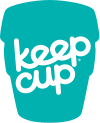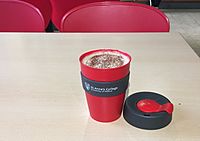KeepCup facts for kids

KeepCup's logo
|
|

A custom design of KeepCup for St Anne's College, Oxford
|
KeepCup is an Australian company. It makes reusable cups for coffee and other drinks. The company started in 2007. A sister and brother, Abigail Forsyth and Jamie Forsyth, founded it. They owned coffee shops in Melbourne, Australia.
They noticed how many single-use coffee cups were thrown away. This made them want to create a better solution. They wanted a cup that baristas could easily use. It also had to be good for customers on the go. KeepCup is known as the first reusable coffee cup designed for baristas.
KeepCup products are sold in many countries. These include Australia, New Zealand, the United States, Canada, Europe, and China. The company says that most of its products are made locally in each region. Only the silicone bands are imported from China.
In 2009, KeepCup wanted 30% of coffee cups to be reused. Many customers reached this goal by 2017. This happened after the ABC TV show War on Waste. The show highlighted that one billion non-recyclable coffee cups go to landfills in Australia each year.
Public awareness about waste grew even more. This was after David Attenborough's Blue Planet II came out. Also, in 2018, the UK Parliament suggested banning disposable cups. This would happen if they were not recyclable by 2023. KeepCup then worked harder to remove disposable cups from public use.
Contents
Helping the Planet
KeepCup is a company that cares about the environment. They work to reduce waste and help protect our planet.
Reducing Waste
By 2019, KeepCup estimated that its users had stopped billions of single-use cups from going to landfills. Landfills are places where trash is buried. These cups cannot be recycled.
Supporting Conservation
KeepCup gives 1% of its sales money to the One Percent for the Planet campaign. They believe it is their duty to help the environment. They also support their employees and communities. KeepCup also works with groups like Sea Shepherd. These groups help protect oceans and marine life.
Environmental Impact
In 2018, KeepCup studied its products' environmental impact. This study is called a life-cycle assessment (LCA). It showed that KeepCups are better for the environment than single-use paper cups. This is true after using a KeepCup 24 times. If you use it once a day, that's 24 days. After just 10 days of use, KeepCups are better than compostable cups.
Future Goals
KeepCup has asked for laws to ban single-use packaging since 2009. They hope the world will be free of single-use packaging by 2023. This shows their strong commitment to a cleaner planet.

